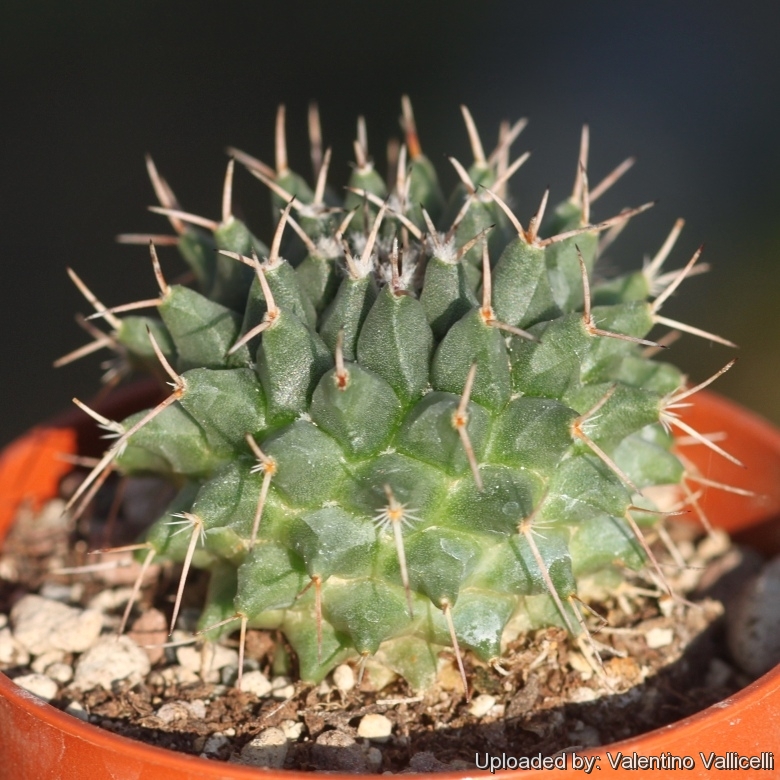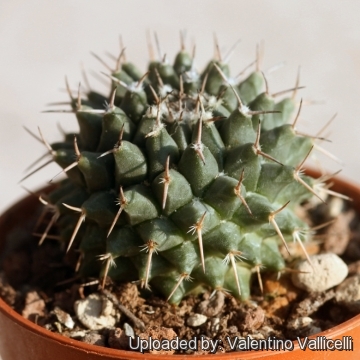Accepted Scientific Name: Mammillaria formosa subs. pseudocrucigera (R.T.Craig) D.R.Hunt
Mammillaria Postscripts 6: 10 (1997)

Mammillaria pseudocrucigera (Mammillaria formosa subs. pseudocrucigera) Photo by: Valentino Vallicelli
Origin and Habitat: Queretaro and Guanajuato (and may be in Hidalgo and San Luis Potosí), Mexico.
Altitude: 1900-2200 m.
Habitat and Ecology: This cactus grows under bushes in xerophytic shrubland, on hills and plains.
Synonyms:
See all synonyms of Mammillaria formosa
Description: Mammillaria formosaSN|20639]]SN|15832]] subs. pseudocrucigera, best known as Mammillaria formosaSN|15832]] is a controversial form of Mammillaria formosaSN|15832]] which is intermediate and often synonymized with Mammillaria semperviviSN|15832]]SN|20639]]. It has pink striped flowers and dense fine white horizontal radials spines and short stout chalky-white central spines more like the proper sempervivi.
Habit: Mostly solitary, or slowly clumping dichotomously flat with ground.
Stem: Symmetrically globose to depressed globose and not rising much above ground level, dull grey-green or olive gray-green, 5-20 cm high, 5-10 (or more) cm in diameter, and may, with age, become rubberized at its base.
Tubercles: Crowded, pyramidal, firm, arranged in numerous 13-21, very close-set spirals. The Axil is woolly with white wool especially in the floriferous portion.
Areoles: Oval and woolly when young.
Radial spines: Mostly hidden under white wool, usually on young stems only, 2 to 18, sometimes absent on mature areoles, white, bristle-like, to 1-3 mm long.
Central spines: 2 to 6, very short, stout, chalky-white to pale brown with darker tips, becoming grey with age, to 3-4(-8) mm long.
Flowers: Diurnal, funnel-form, in a rings on the crown barely rising above the tubercles, in the growth of the previous year, pinkish-white with a darker pink midstripe, 1-2 cm long and diameter.
Blooming season: Flowering period spring to summer.
Fruits: Club-shaped, attractively deep red coloured to 10 mm long.
Seed: Brown.
More...Subspecies, varieties, forms and cultivars of plants belonging to the Mammillaria formosa group
 Mammillaria formosa Galeotti ex Scheidw.: has pale pink flowers and 20-22 white radial spines. Distribution: Coahuila, Aguascalientes, Guanajuato, Zacatecas, Tamaulipas, Nuevo Leon, and San Luis Potosi.
Mammillaria formosa Galeotti ex Scheidw.: has pale pink flowers and 20-22 white radial spines. Distribution: Coahuila, Aguascalientes, Guanajuato, Zacatecas, Tamaulipas, Nuevo Leon, and San Luis Potosi. Mammillaria formosa subs. chionocephala (J.A.Purpus) D.R.Hunt: is typically wrapped on the upper part with a dense snow-white wool, so that only the tips of the tubercles visible. Distribution: Highlands of central Mexico (Coahuila, Nuevo Leon, and Durango).
Mammillaria formosa subs. chionocephala (J.A.Purpus) D.R.Hunt: is typically wrapped on the upper part with a dense snow-white wool, so that only the tips of the tubercles visible. Distribution: Highlands of central Mexico (Coahuila, Nuevo Leon, and Durango). Mammillaria formosa subs. microthele (Muehlenpf.) D.R.Hunt: has nearly pure white flowers and 22-24 flattened and bristle-like radials. Description: Coahuila, Guanajuato, Tamaulipas, and San Luis Potosi.
Mammillaria formosa subs. microthele (Muehlenpf.) D.R.Hunt: has nearly pure white flowers and 22-24 flattened and bristle-like radials. Description: Coahuila, Guanajuato, Tamaulipas, and San Luis Potosi. Mammillaria formosa subs. microthele var. superfina hort.: it is a particular nice selected form with very small tubercles and spines.
Mammillaria formosa subs. microthele var. superfina hort.: it is a particular nice selected form with very small tubercles and spines. Mammillaria formosa subs. pseudocrucigera (R.T.Craig) D.R.Hunt: has distinctly pink flowers with white margins and only 18 radials, often lacking on mature areoles. Distribution: Queretaro and Guanajuato.
Mammillaria formosa subs. pseudocrucigera (R.T.Craig) D.R.Hunt: has distinctly pink flowers with white margins and only 18 radials, often lacking on mature areoles. Distribution: Queretaro and Guanajuato.
Notes: The white wool between the areoles makes this species a pleasure to look at and grow, but the diversity among individual specimens is considerable and the best plants have abundant white axillary wool. Hence, it is worth raising a batch of seedlings and selecting one or two that have the most wool.
Bibliography: Major references and further lectures
1) David Hunt, Nigel Taylor “The New Cactus Lexicon” DH Books, 2006
2) John Pilbeam (1999) “Mammillaria The Cactus File Handbook” Nuffield Press.
3) Nathaniel Lord Britton, Joseph Nelson Rose “Cactaceae: Descriptions and Illustrations of Plants of the Cactus Family” vol. 4 The Carnegie Institution of Washington, Washington 1923
4) Stuart Max Walters “The European Garden Flora: Dicotyledons (Part I)” Cambridge University Press, 1989
5) Edward F. Anderson “The Cactus Family” Timber Press, 2001
6) Fitz Maurice, B, Fitz Maurice, W.A., Hernández, H.M., Sotomayor, M. & Smith, M. 2013. Mammillaria formosa. In: IUCN 2013. “IUCN Red List of Threatened Species.” Version 2013.2. <www.iucnredlist.org>. Downloaded on 01 January 2014.
More... Mammillaria pseudocrucigera (Mammillaria formosa subs. pseudocrucigera) Photo by: Valentino Vallicelli
Mammillaria pseudocrucigera (Mammillaria formosa subs. pseudocrucigera) Photo by: Valentino VallicelliSend a photo of this plant.The gallery now contains thousands of pictures, however it is possible to do even more. We are, of course, seeking photos of species not yet shown in the gallery but not only that, we are also looking for better pictures than those already present.
Read More... Cultivation and Propagation: It is easy to cultivate and make interesting specimens for any collection, and over time (in 12-15 years) it will form enormous colonies up to 50 cm or more in diameter! It grows by dichotomously dividing, and also by producing offsets, and doesn't require any special treatment, except for the need for frequent transplanting, in order to manage its exuberance. It needs as much light as possible without burning the plant, to keep the stems compact. Provide a well-drained soil mix. Water well and then allow to dry thoroughly before watering again during the growing season. It doesn't like much, if any, winter water, but can survive short exposures to freezing temperatures (-4° C.) if properly hardened off and kept dry.
Propagation: It is best propagated from seed. Seed readily germinates at 20°-22°C, or by offsets if available. The white wool between the areoles makes this species a pleasure to look at and grow, but the diversity among individual specimens is considerable and the best plants have abundant white axillary wool. Hence, it is worth raising a batch of seedlings and selecting one or two that have the most wool.
More...












